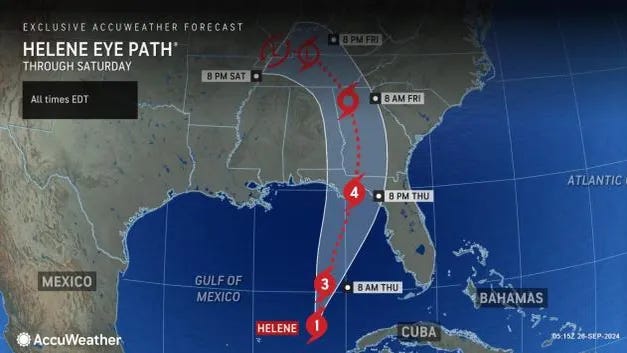If you were to ask me what places would be most impacted by a Category 4 hurricane that traveled through the Caribbean, up the Gulf Coast, and made landfall on Florida’s armpit, I would never have guessed Appalachia. I’m an Appalachian expat living in Gainesville, FL currently and assumed my home would be a lot worse off than Chimney Rock, NC, but that is most certainly not the case.
Flooding is the costliest natural disaster and can truly ruin lives in ways you would have never imagined. There will be plenty of time to discuss how climate change has exacerbated this and what communities can do to be more prepared. But right now we want to focus on what has happened and what you can do to help people.
Some Facts about what the response is looking like
Hurricane Helene caused unspeakable tragedy across the southeastern United States
There are at least 125 confirmed deaths as of 6pm ET today (Sept 30th), and the White House Homeland Security Advisor, Liz Sherwood-Randall, suggested as many as 600 people haven’t been accounted for.
Thankfully, it appears that the federal and state governments are mobilizing response teams swiftly (knock on wood!), and we’ve heard from people on the ground in places like Asheville that they’ve already been helped by the national guard and FEMA.
FEMA has dispatched more than 900 search and rescue personnel, 200 federal ambulances, and 40 Starlink systems in North Carolina alone, and President Biden has directed FEMA’s Administrator (the head of the agency) to stay in North Carolina until the situation is stabilized.
The North Carolina National Guard announced today that they have over 100,000 pounds of supplies from FEMA being distributed to WNC as we speak
The White House mobilized a “whole of government” response by dispatching over 3,500 federal personnel across NC, GA, FL, TN, SC, and AL.
This disaster is huge and is going to take a long time to fully recover from. Some places may not recover as the devastation has been so horrible.
However, our community is showing what it means to be good neighbors.
Appalachians from across the country have mobilized to offer help and resources to victims of the storm.

How you can help!
There are tons of funds, groups, etc. taking money and putting it to good use, so we will share a few things below that you can do right now to help.
Jessica Burbank has been working with us and other partners in the region on a shared Google doc that lists a lot of places to donate, places to get help, and resources for what victims need to do in the aftermath to ensure they can access recovery money. Please view and share this with anyone you know!
Big John made a shirt that we are selling and donating 100% of the profits to flood relief organizations in Appalachia, and the site that hosts our store — Teepublic — has agreed to match that amount up to $1,000. We are almost there if you want to buy one and support this cause.
The Foundation for Appalachian Kentucky has organized an Appalachian Helene Response Fund that you can donate to.
North Carolina has a specific fund set up to help victims of the hurricane. You can donate directly to the North Carolina Disaster Relief Fund here.
We’re hoping to do more in the future, but for now we are doing what we can. I’m hoping we can be a part of a bigger fundraiser in the coming days and weeks, but mostly I’m just hoping first responders can find and save as many people as possible. This is truly heartbreaking. Just know that we are thinking about you, praying for you, and trying our best to do everything we can to help y’all.
Appalachia will have scars from this no doubt, but it will recover from this. It will recover because of all the good people who are coming to the region’s aid. The one thing we can take solace in is the amount of strangers who have reached out to ask how they can help, donated to relief funds, and spread words of encouragement and love to those affected.
Love y’all
— Chuck







Mutual aid runs strong and deep in this region.